Stacked fractions: Difference between revisions
Jump to navigation
Jump to search
No edit summary |
(Added reference for convoluted example due to Barry Mazur who was trying to annoy Serge Lang.) |
||
| (One intermediate revision by one other user not shown) | |||
| Line 1: | Line 1: | ||
[[Category:Ambiguities]] | [[Category:Ambiguities]] | ||
[[Category:Handwriting]] | |||
A fraction written on multiple levels is often ambiguous, especially when handwritten. For example, \(\frac{10}{\frac{2}{5}}\) and \(\frac{\frac{10}{2}}{5}\) result in 25 and 1, respectively. | A fraction written on multiple levels is often ambiguous, especially when handwritten. For example, \(\frac{10}{\frac{2}{5}}\) and \(\frac{\frac{10}{2}}{5}\) result in 25 and 1, respectively. | ||
Things get even worse when you use the letter \(\Xi\) in this convoluted example: | Things get even worse when you use the letter \(\Xi\) in this convoluted example<ref>[http://www.ams.org/notices/200605/fea-lang.pdf AMS Notices: Remembrances of Serge Lang]</ref>: | ||
[[File:Xi bar over Xi .jpg|thumb|center|alt=A handwritten stacked fraction with Xi bar divided by Xi. In effect it looks like nothing more than a stack of eight horizontal lines of varying sizes.|\(\frac{\bar \Xi}{\Xi}\), handwritten]] | [[File:Xi bar over Xi .jpg|thumb|center|alt=A handwritten stacked fraction with Xi bar divided by Xi. In effect it looks like nothing more than a stack of eight horizontal lines of varying sizes.|\(\frac{\bar \Xi}{\Xi}\), handwritten]] | ||
Latest revision as of 16:38, 12 July 2021
A fraction written on multiple levels is often ambiguous, especially when handwritten. For example, \(\frac{10}{\frac{2}{5}}\) and \(\frac{\frac{10}{2}}{5}\) result in 25 and 1, respectively.
Things get even worse when you use the letter \(\Xi\) in this convoluted example[1]:
